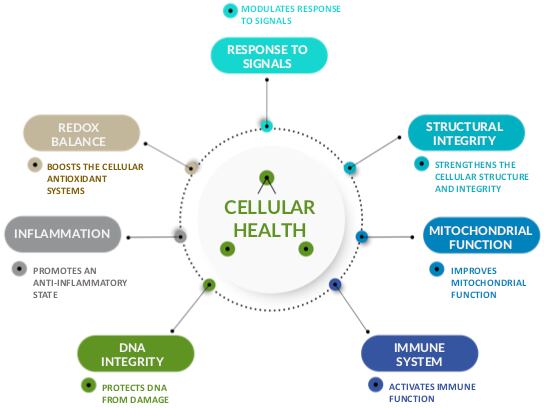Microalgae were among the first photosynthetic organisms that appeared on Earth during the evolution of life.
Thanks to oxygenic photosynthetic activity, microalgae were responsible for the progressive transformation of the primitive anoxygenic atmosphere through the delivery of oxygen, allowing new forms of life to emerge. Owing to their enormous physiological plasticity, microalgae can be found even in the most hostile environments.
Such capacity is based on the production of molecules of very diverse chemical nature (peptides and proteins, polyunsaturated fatty acids (PUFAs), polysaccharides, pigments, phytosterols, and phenolic compounds), which can exhibit potential bioactivities of great interest for human health.1,2
Cellular health
The concept of cellular health has gained increasing interest in recent years and is today considered the basis of overall health. The cell is the basic unit of life, as it is the smallest structural and functional unit in organisms capable of performing all of the necessary processes for life. Cells associate to form tissues through a process referred to as cell aggregation – tissues for organs – which in turn form systems.
All of the systems together make up the human body and cellular health can be considered as the microscopic version of the overall health – healthy cells are essential for a healthy body.
Cellular health can be compromised by stress due to external (pollution, radiation, smoke) or internal (such as oxidative stress) factors. However, it can be improved by stress-reducing activities (such as a balanced lifestyle or proper nutrition) owing to the positive influence in a range of key factors for cellular homeostasis and function, thereby contributing to cellular health (Figure 1).

Figure 1. Key factors contributing to cellular health
Among these factors, the most important ones include:
- Redox balance Oxidative stress is known to damage DNA, proteins, carbohydrates, and lipids, altering the cell function
- Inflammation This is a fundamental part of the immune response, but when it is out of control, as happens in chronic processes, tissues can be damaged
- DNA integrity Damage to the DNA, if not properly repaired, can lead to mutations contributing to a number of diseases
- Immune system interactions The immune system is involved not only in fighting against pathogens, but also in the elimination of damaged or infected cells, and abnormal cells that might degenerate in neoplastic processes
- Mitochondrial function As the powerhouses of the cell, mitochondria generate energy in the form of ATP, which is further used in different processes of cellular metabolism
- Cellular structure and integrity Healthy cells have well-defined structures and compartments, whose integrity is fundamental for normal cell function
- Response to signals Healthy cells can respond appropriately to signals from their environment or neighboring cells, triggering processes like cell division, differentiation, and apoptosis
Promoter of cellular health
TetraSOD® is a unique marine ingredient derived from the green eukaryotic microalgae species Tetraselmis chuii. It is produced using a patent-protected technology by Fitoplancton Marino, S.L. under culture conditions that ensure a significantly high Superoxide Dismutase (SOD) activity, above 30,000 U/g of freeze-dried biomass.
This feature, together with its high ORAC 5.0 value (34,300 µmol TE/100 g), makes TetraSOD a powerful direct antioxidant. Moreover, in TetraSOD’s composition, additional components with potential bioactivity can also be found, such as PUFAs, vitamins, carotenoids, polyphenols, or phytosterols.3,4
The outcomes of both in vitro and in vivo research, reveal that TetraSOD has a positive influence in all factors known to contribute to cellular health.5-13 That is to say, TetraSOD behaves as a promoter of cellular health (Figure 2).

Figure 2. TetraSOD effects in factors contributing to cellular health
TetraSOD is a potent indirect antioxidant as it boosts cellular antioxidant mechanisms, revealed by the decrease in different markers of oxidative stress (oxidized LDL, malondialdehyde, static Oxidation-Reduction Potential) after TetraSOD supplementation.
It activates the main antioxidant enzymes (SOD, glutathione peroxidase, and catalase). It also up-regulates genes encoding such enzymes, simultaneously increasing glutathione levels and up-regulating genes involved in glutathione biosynthesis and recycling (GCLC, GCLM, GSH-S, and GSR).
TetraSOD displays anti-inflammatory properties, up-regulating the main anti-inflammatory cytokine (IL-10), and down-regulating pro-inflammatory cytokines (IL-1b, TNFa, IFNg, TGF-b1) and transcription factors (NF-kB1). It also protects DNA from damage, reducing double-strand DNA breaks, together with a parallel up-regulation of key genes involved in DNA repair and genome stability.
TetraSOD can activate immune function, as demonstrated by the increase in levels of salivary IgA, and in the counts of immune cells such as basophils, monocytes and lymphocytes. It can also improve mitochondrial function, up-regulating key genes involved in mitochondrial biogenesis, ATP synthesis, and defense against oxidative stress.
TetraSOD strengthens cell structure and integrity, decreasing markers of cellular damage (creatine kinase, myoglobin), and activating genes and factors involved in cell differentiation and tissue repair. Moreover, TetraSOD modulates cellular signaling pathways, modifying the expression of MAPK genes and components of the AP-1 factor.
An activator of both NRF2 and SIRT1
The molecular mechanisms underlying these effects on cellular health have begun to be understood.5-13 Two key factors activated by TetraSOD in human cells and tissues have appeared as pivotal players:
- The nuclear factor NRF2, which is considered the central player to reach cellular homeostasis and the master of the cellular antioxidant response, controlling the expression of more than 200 genes, most of them with a cytoprotective function.14
- SIRT1, a deacetylase enzyme well known for its role in multiple biological processes, including cellular senescence, cell death, sugar and lipid metabolism, mitochondrial biogenesis, maintenance of genomic stability, and oxidative stress and inflammation.15
Moreover, it has been reported that SIRT1 can deacetylate NRF2, and this modification has been related to an increase in stability, nuclear localization, and transcriptional activity of NRF2.16
A homeostatic response in human tissues
A deeper analysis of gene expression results obtained from clinical trials has revealed that TetraSOD induces a homeostatic response.13 In this regard, a significant up-regulation of the target genes was only detected in individuals who exhibited low expression levels at baseline: the lower was the expression of the gene, the higher was the activation.
This effect was observed in more than 90% of the studied genes. This means that TetraSOD behaves as a modulator of the cellular response, activating gene expression when there is a real need for activation. This represents a fundamental finding to explain the benefits of TetraSOD on human health.
Physiological benefits
The homeostatic effect at molecular level is also observed at overall physiological level. As a promoter of cellular health, TetraSOD has demonstrated in clinical trials to provide benefits regarding physical performance (increase in muscle strength, power and recovery; increase in aerobic power, or decrease in muscle fatigue).7-10
Benefits are also seen in seminal parameters of infertile men (increase in semen volume, concentration, number and motility of sperms, decrease in double-strand DNA breaks, and reduction in oxidative stress markers).11
Cellular health is crucial for overall wellbeing and TetraSOD can be adapted for a range of health applications, such as healthy aging, by activating cell regeneration and tissue repair, and helping counteract the decline in the activity of the main antioxidant systems that is known to happen as we age.
It can also be used for health challenges in which oxidative stress and chronic inflammatory processes underlie tissue damage, and for people who want to maintain a healthy and active lifestyle, for which supporting cellular health is a fundamental step.
Author: Carlos Infante, Scientific Director at Fitoplancton Marino, S.L.
References
1. Barkia, I.; Saari, N.; Manning, S.R. (2019). Microalgae for High-Value Products towards Human Health and Nutrition. Mar. Drugs, 17, 304.
2. Ampofo, J.; Abbey, L. (2022). Microalgae: Bioactive Composition, Health Benefits, Safety and Prospects as Potential High-Value Ingredients for the Functional Food Industry. Foods,11, 1744.
3. Mantecón, L.; Moyano, R.; Cameán, A.M.; (2019). Safety assessment of a lyophilized biomass of Tetraselmis chuii (TetraSOD®) in a 90 day feeding study. Food Chem Toxicol. 133:110810.
4. Cokdinleyen, M.; Alvarez-Rivera, G.; Tejera, J.L.G.; et al. (2024). Tetraselmis chuii Edible Microalga as a New Source of Neuroprotective Compounds Obtained Using Fast Biosolvent Extraction. Int J Mol Sci. 25(7):3897.
5. Ramírez, P.; Torres, S.; Lama, C.; et al. (2020). TetraSOD® Activates the Antioxidant Response Pathway in Human Cells: An in Vitro Approach. African J. Biotechnol. 19, 367–373.
6. Gil-Cardoso, K.; Del Bas, J.M.; Caimari, A.; et al. (2022). TetraSOD®, a Unique Marine Microalgae Ingredient, Promotes an Antioxidant and Anti-Inflammatory Status in a Metabolic Syndrome-Induced Model in Rats. Nutrients, 14, 4028.
7. Sharp, M.; Sahin, K.; Stefan, M.; et al. (2020). Phytoplankton Supplementation Lowers Muscle Damage and Sustains Performance across Repeated Exercise Bouts in Humans and Improves Antioxidant Capacity in a Mechanistic Animal. Nutrients, 12(7).
8. Sharp, M.H.; Sahin, K.; Stefan, M.W.; et al. (2021). Marine Phytoplankton Improves Exercise Recovery in Humans and Activates Repair Mechanisms in Rats. Int. J. Sports Med. 42, 1070–1082.
9. Sharp, M.; Wilson, J.; Stefan, M.; et al. (2021). Marine Phytoplankton Improves Recovery and Sustains Immune Function in Humans and Lowers Proinflammatory Immunoregulatory Cytokines in a Rat Model. Phys. Act. Nutr. 25, 42–55.
10. Toro, V.; Siquier-Coll, J.; Bartolomé, I.; et al. (2020). Effects of Tetraselmis Chuii Microalgae Supplementation on Ergospirometric, Haematological and Biochemical Parameters in Amateur Soccer Players. Int. J. Environ. Res. Public Health, 17, 1–12.
11. Corral, J.M.; Jodar, M.; Matheu, R.; et al. (2023). Improvement of Semen Quality in Idiopathic Infertile Men by Dietary Supplementation with TetraSOD®: A Pilot Clinical Trial. Bimedical J. Sci. Tech. Res. 50, 41971–41975.
12. García, Á.; Toro-Román, V.; Siquier-Coll, J.; et al. (2022). Effects of Tetraselmis Chuii Microalgae Supplementation on Anthropometric, Hormonal and Hematological Parameters in Healthy Young Men: A Double-Blind Study. Int. J. Environ. Res. Public Health, 19, 1–16.
13. Cocksedge et al. Manuscript in preparation (Loughborough University and Fitoplancton Marino, S.L.).
14. Hayes, J.D.; Dinkova-Kostova, A.T. (2014). The Nrf2 Regulatory Network Provides an Interface between Redox and Intermediary Metabolism. Trends Biochem. Sci, 39, 199–218.
15. Rahman, S.; Islam, R. (2011). Mammalian Sirt1: Insights on Its Biological Functions. Cell Commun. Signal, 9, 11.
16. Kratz, E.M.; Sołkiewicz, K.; Kubis-Kubiak, A.; et al. (2021). Sirtuins as Important Factors in Pathological States and the Role of Their Molecular Activity Modulators. Int. J. Mol. Sci, 22, 630.





